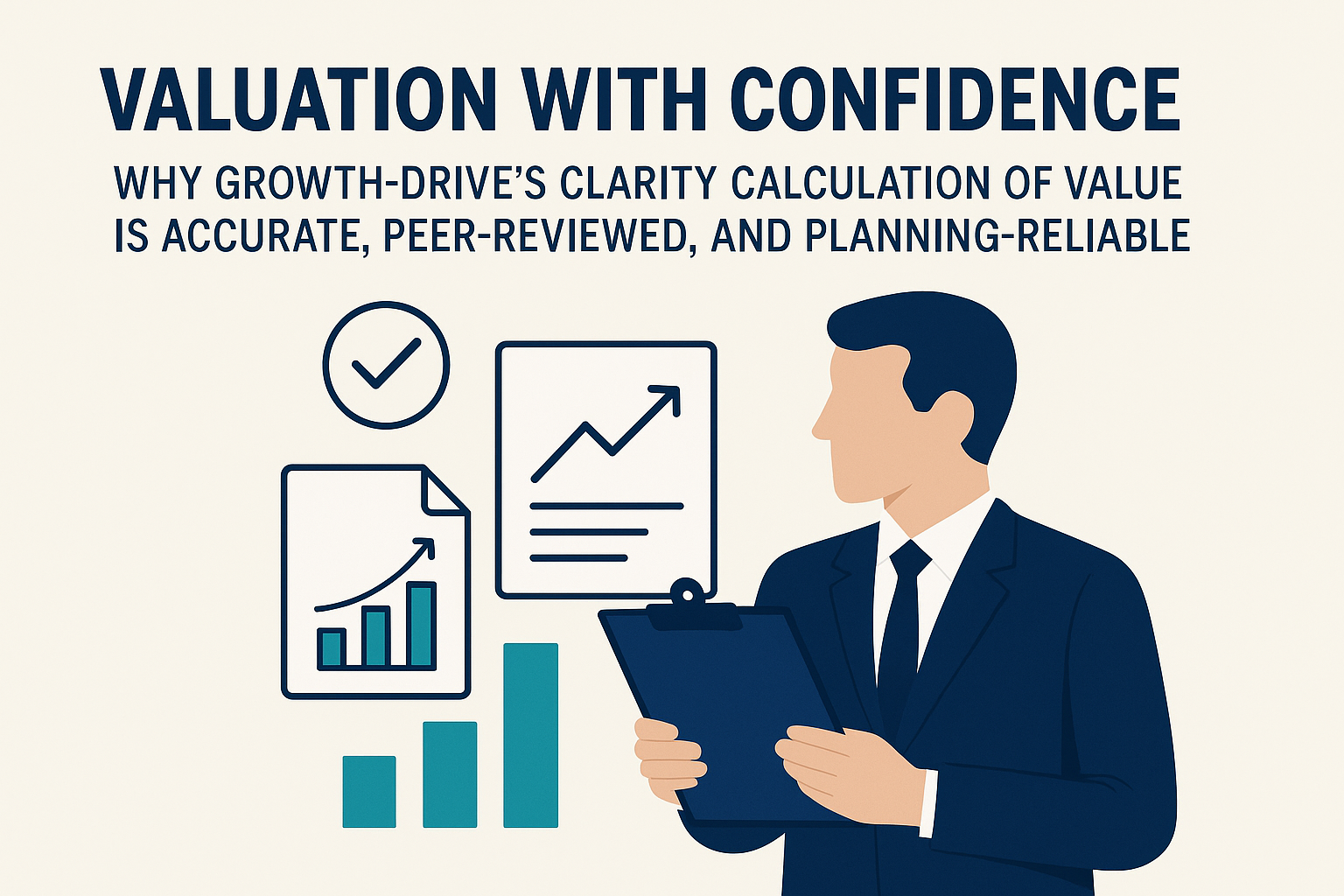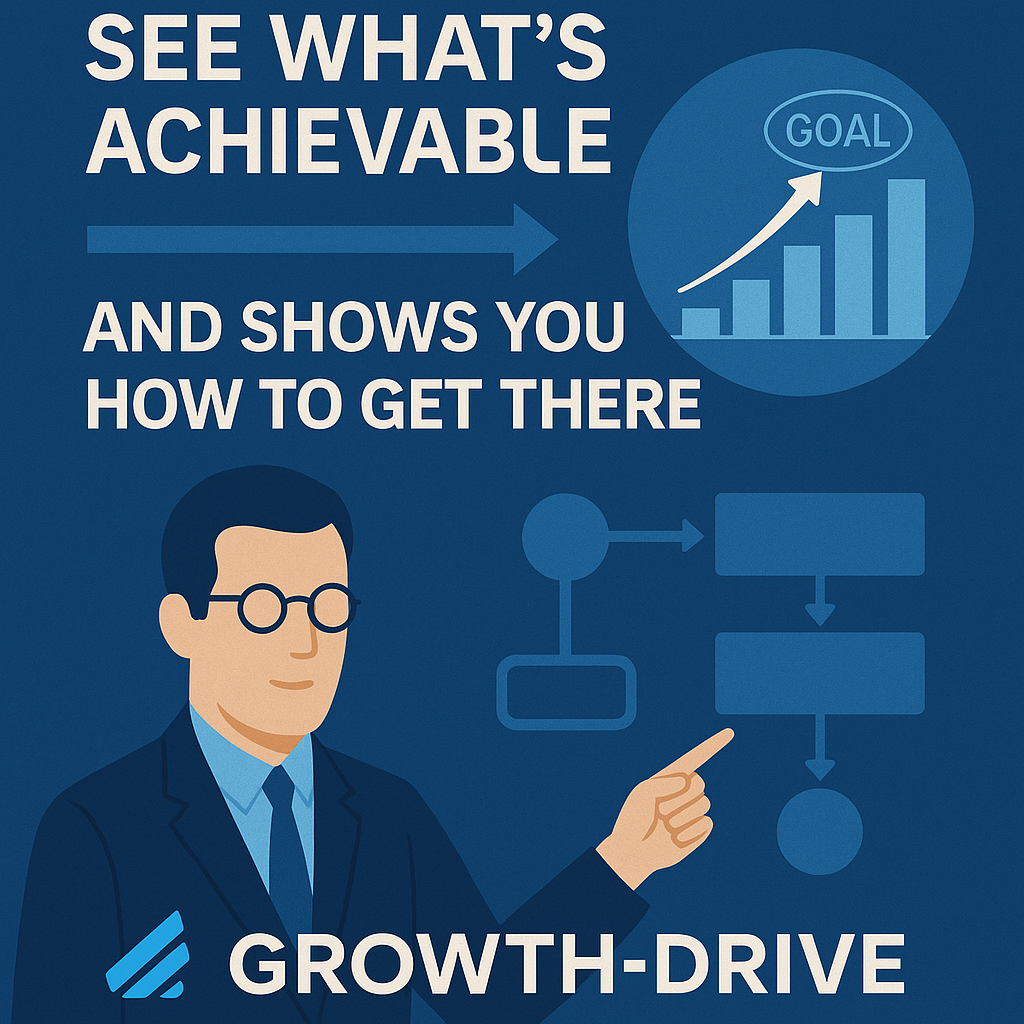Valuation + Confidence
Valuation With Confidence: Why Growth-Drive’s CLARITY Calculation of Value Is Accurate, Peer-Reviewed, and Planning-Reliable By George Sandmann,...
Business advisors are using the Growth-Drive System for winning and executing valuable client engagements. What does this look like in the field? Check out this case and get your free glossary of terms to find out.
The following case looks at Ridge Speciality Tooling, the case used in our courses. Ridge is owned and run by Diane, who worked with veteran growth advisor Steve.
Let’s look at how the analysis of Ridge’s capacity was leveraged to increase Steve’s ability to drive the client forward.

To begin with, the very act of discussing Ridge’s strategic capacity in the context of defined best practices helped Diane decide to get the advisory ball rolling. When it comes to motivating a CEO there is no substitute for hearing themselves say they're not clearing the best-in-class bar.
Before the engagement even started, Steve led Diane through a Growth Conversation. Steve used sophisticated discovery techniques to help Diane define her dreams for herself, her family and the business, and then to gain and share clarity on the business’ capacity to deliver these dreams. The trust and value from this discussion led Diane to hire Steve, whose first project helped Diane understand Ridge Specialty Tool’s strengths and bottlenecks.
Due diligence is designed to confirm a business' future ability to deliver predictable cash, growth and transferable value. Savvy advisors are helping their clients execute a self-directed private equity play by implementing due diligence's best-in-class performance standards. Here at Growth-Drive we call these Growth-Driving Objectives, the heart of the business advisory system taught in our Launch Course and Playbook.
Redesigning a business so that it delivers growing profits and transferable value requires you to understand a business in the context of best practices, aka Strategic Capacity, so a score is crucial. If high Strategic Capacity is 100, where does Diane fall? Analysis of Ridge delivered a Growth Capacity score of 57% and Value Capacity score of 45%. The process showed Diane that without executing a redesign of her business she could not reach her personal and professional goals (dreams). This creates the emotional link between Steve’s expertise and Diane's need to fix the business. The analysis (using a tool like Growth-Drive's CLARITY) also identified deal killers that would need to be cleared before attempting to monetize value through an M&A or other transaction.
Pro tip: for a better understanding of the terms used in this and our other articles, please grab your copy of the glossary of business advisory terms:

We’ll focus on building 'Effective Senior Leadership' to illustrate the impact of this analysis. Having an ‘Effective Senior Leadership Team’ is the first growth-driving objective in Dimension 1 of the 3 Dimensions of Business Growth.
Here is the ‘Effective Leadership Team’ in OKR detail:
Objective: Your business has an effective leadership team that is aligned with and accountable to the business' vision and mission, helping the shareholders achieve their objectives.
Now here are the Key Results which guide bringing the business in line with this growth-driving objective:
Let’s game out the immediate impact analysis had on just this one objective through Diane and Steve’s experience with Ridge.
During initial analysis Diane indicated that it was "Partly True" that the business ran smoothly in her absence… but as it is with many CEOs ‘partly true’ was a fairytale. In reality the business needed her every day.
The analysis identified that what she had not done was to establish a time-bound transferable value goal nor was she sharing her goals with the senior leadership team. Why wan't she? Diane was worried about the team’s reaction to learning that the business might be sold.
Steve also ran the analysis with the rest of the senior team, and here are their answers. Diane is respondent 3.
No one including Diane thought the business could run smoothly in her absence. Two folks thought it was partly true, and three (or 60%) answered with a flat “No.” If the team is to be accountable for helping Diane reach her goals, they need to be read in on the goals and given the tools to help get there, right?
The analysis process itself educated Diane to the standards to which pros like PEGs hold their portfolio businesses. Diane saw that she and her team could either implement best practices or leave money on the M&A deal table. Powerful motivation.
What happened next? Steve worked with Diane to create and execute a sprint (project) to up their game. Steve was staring to help Diana implement a system like Growth-Drive's Execution Management System to get her team aligned and accountable, sowing the seeds for establishing a Strategic Culture (another of the 24 Growth-Driving Objectives).
Diane is smart and motivated, and with Steve’s plan Diane:
Imagine harnessing a system like this as you build your advisory business. Your colleagues are using the system and methodology to make informed decisions in a logical sequence, creating a launchpad for growing profits and value and then lighting the rocket. High confidence, high ROI, with the groundwork done for delivering client wins. What could be better than that?
This is an excerpt from George Sandmann's upcoming book Growth-Drive being published by Advantage|FORBES. Joining the publication list is easy: just click here.
Author's note: The training, tools and support you need for building you advisory business and delivering client wins is all included in Growth-Drive's system.
We'd love to know what you think, please comment below or email blog@growth-drive.com.

Valuation With Confidence: Why Growth-Drive’s CLARITY Calculation of Value Is Accurate, Peer-Reviewed, and Planning-Reliable By George Sandmann,...

When Tip, a seasoned business advisor, walked into an eight-hour strategy meeting with his client’s senior leadership team, he wasn’t sure what to...